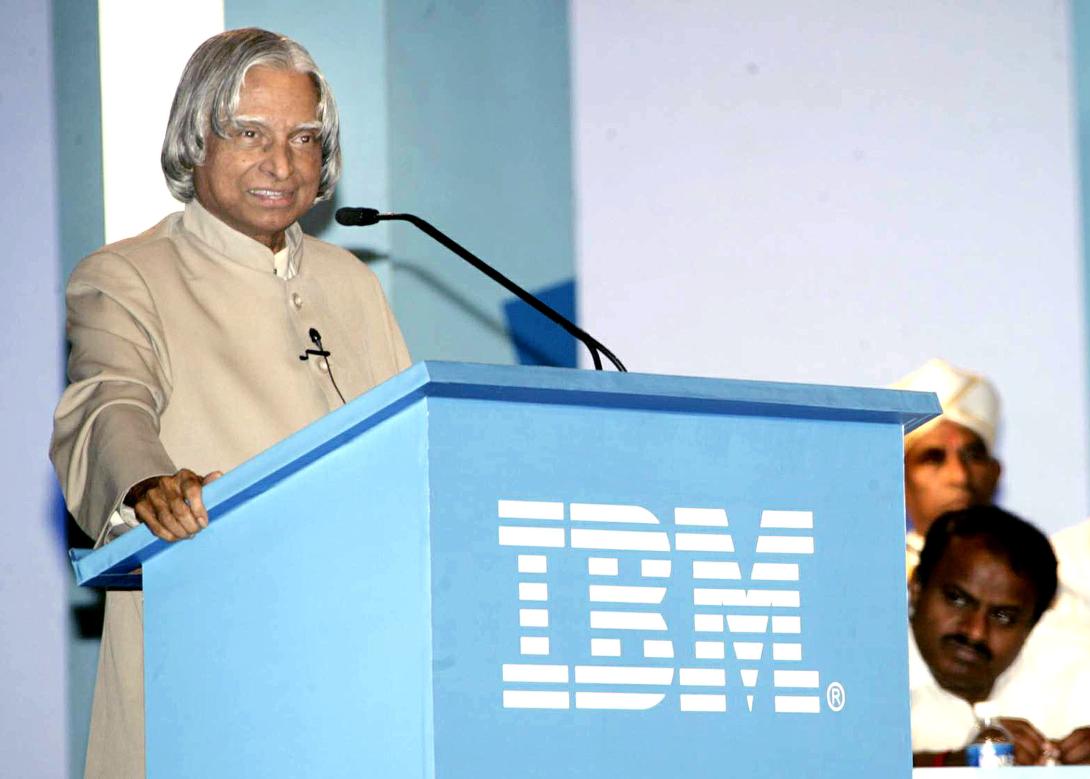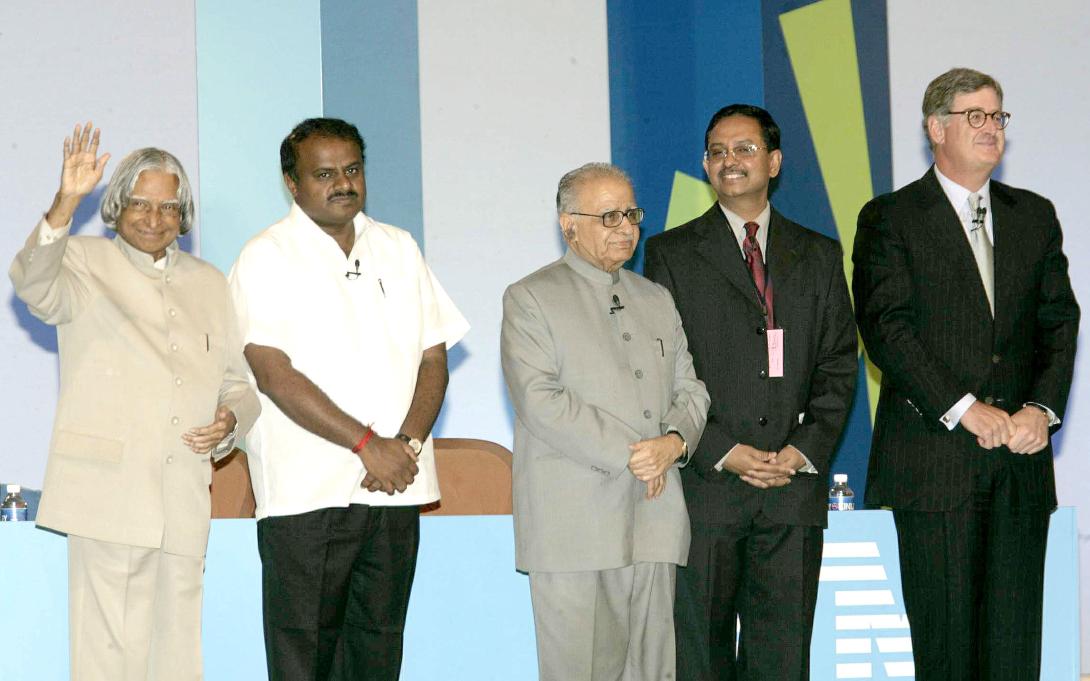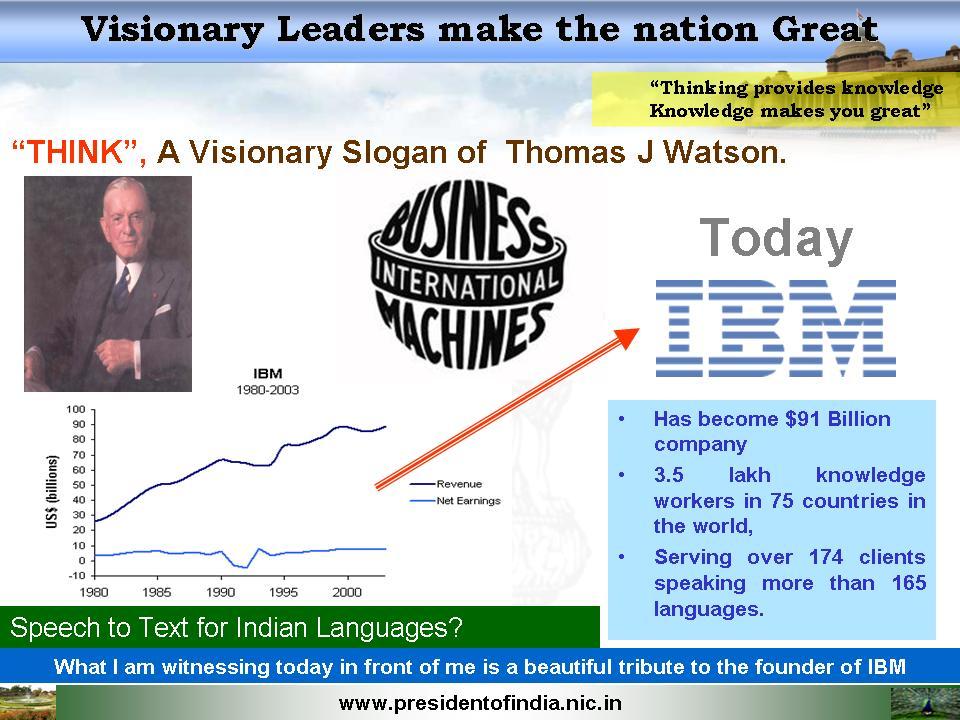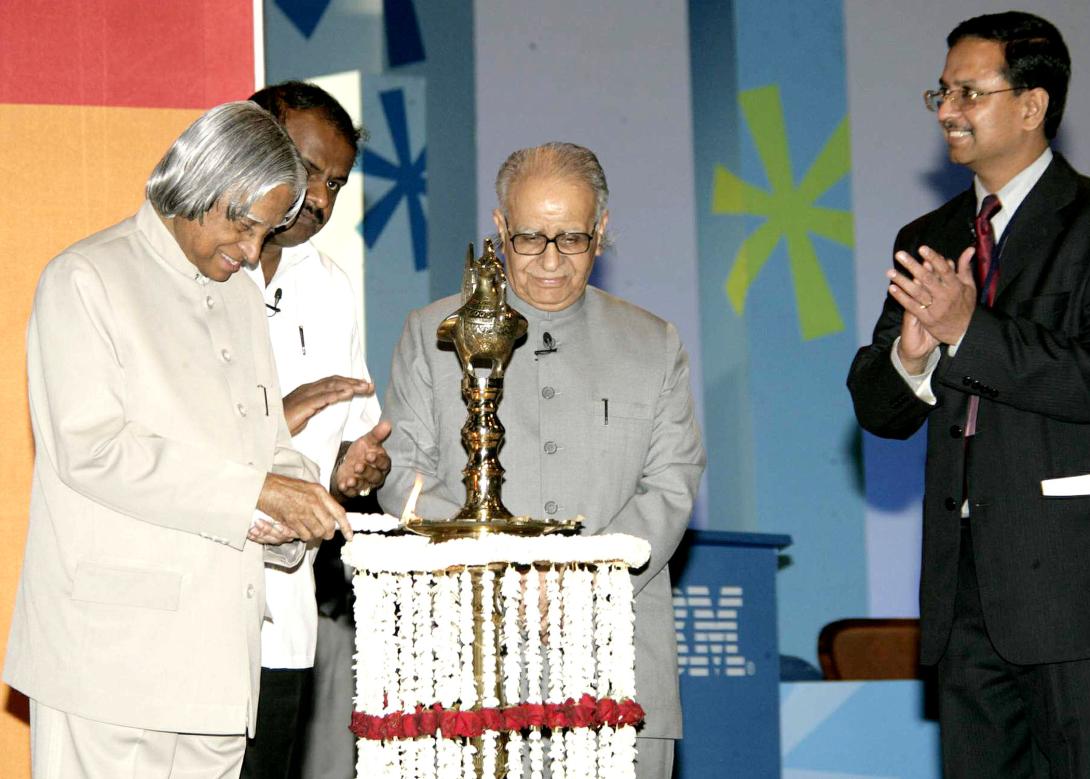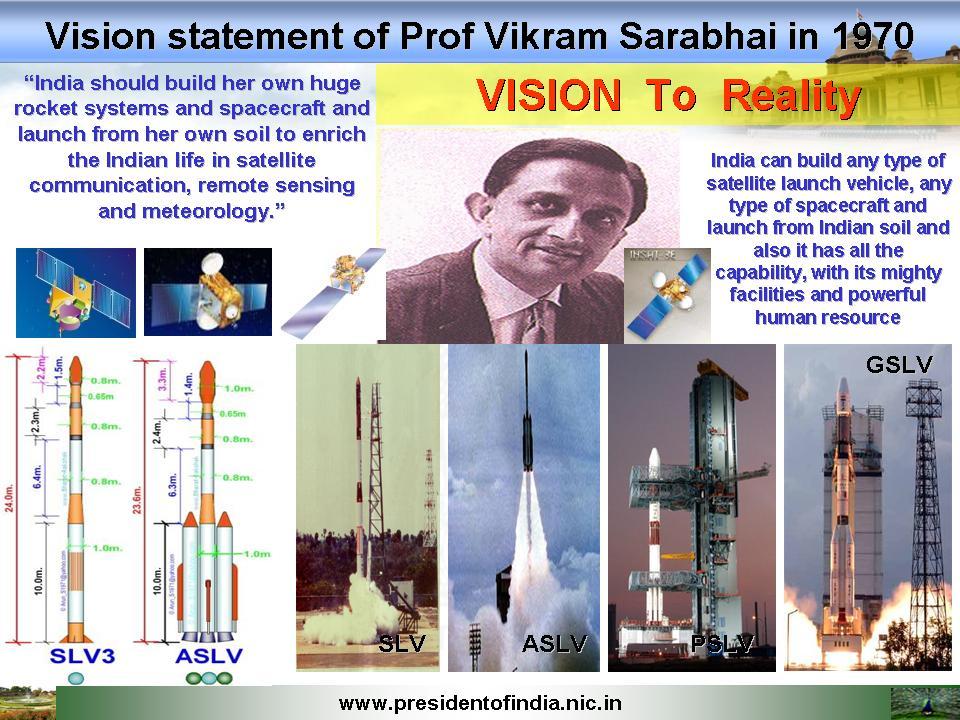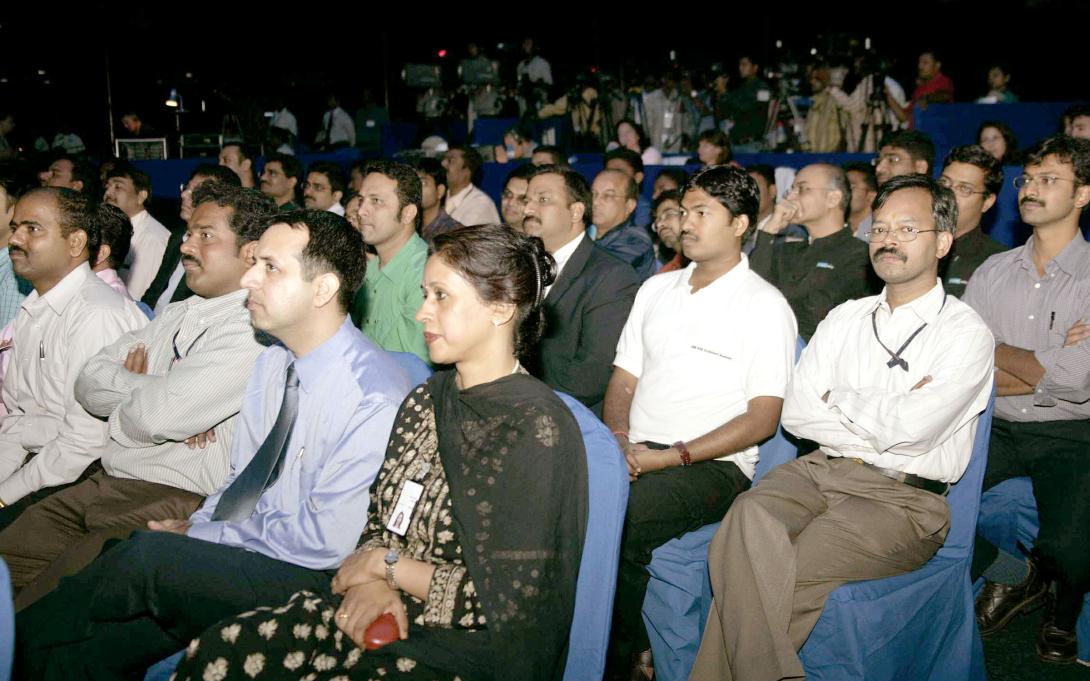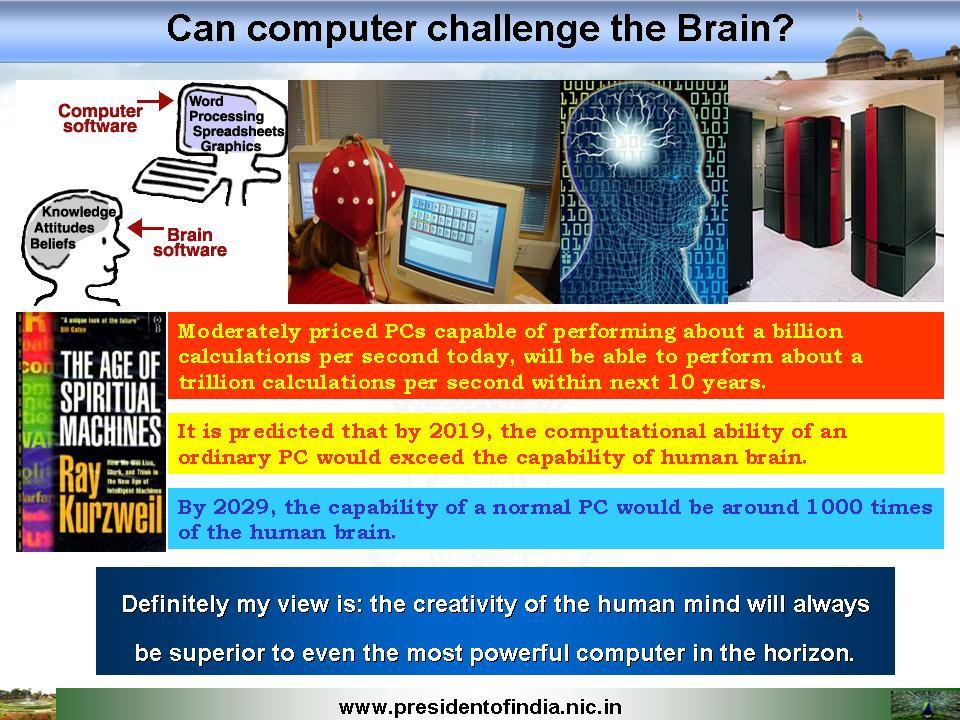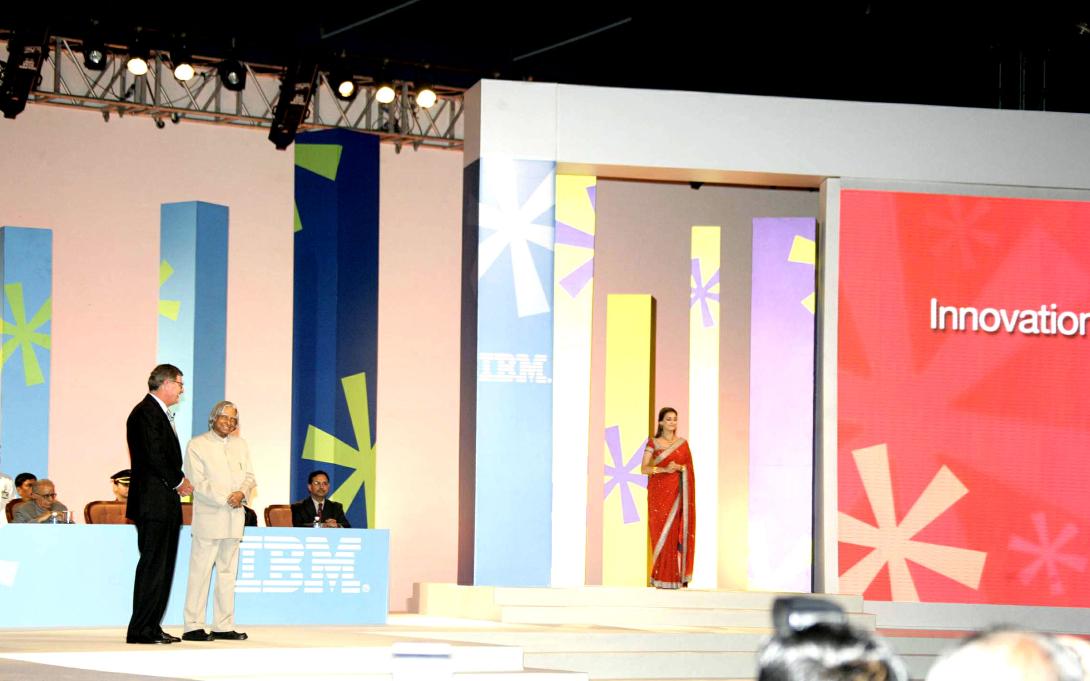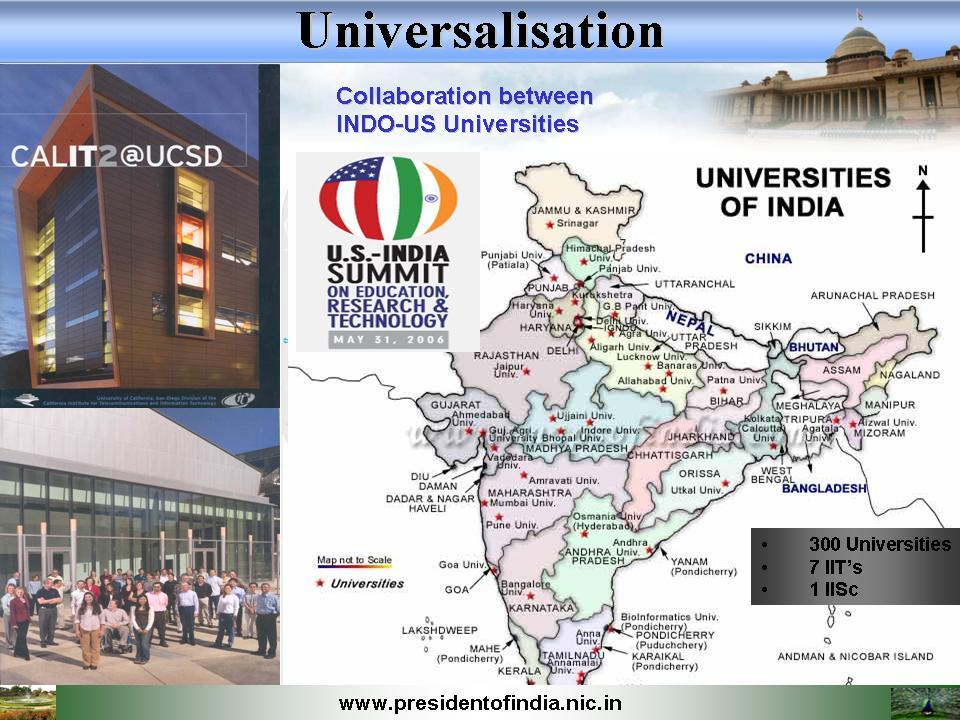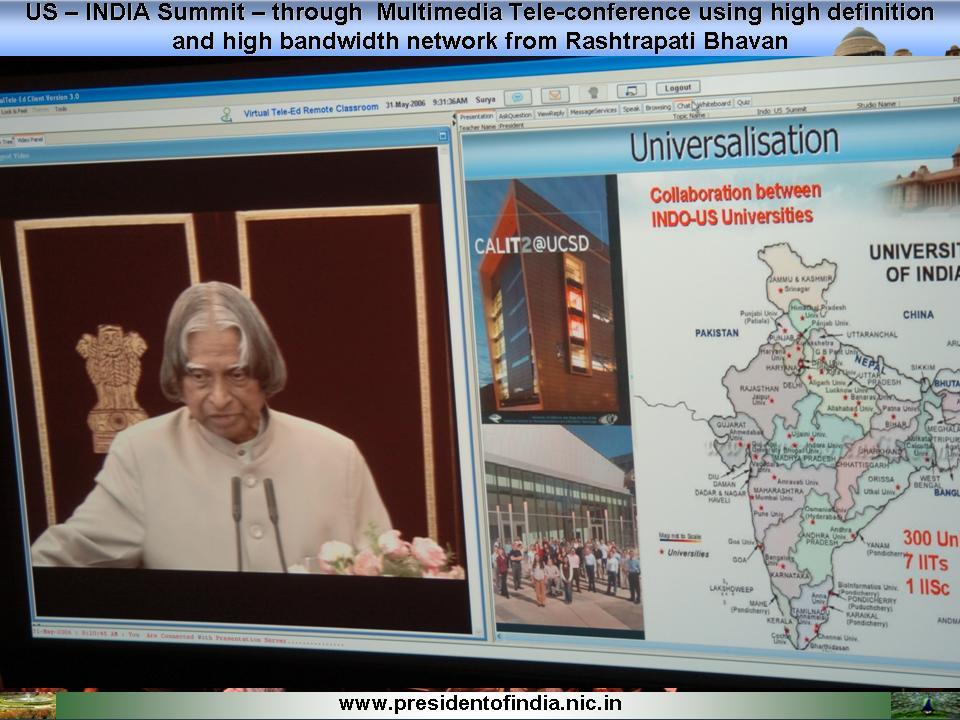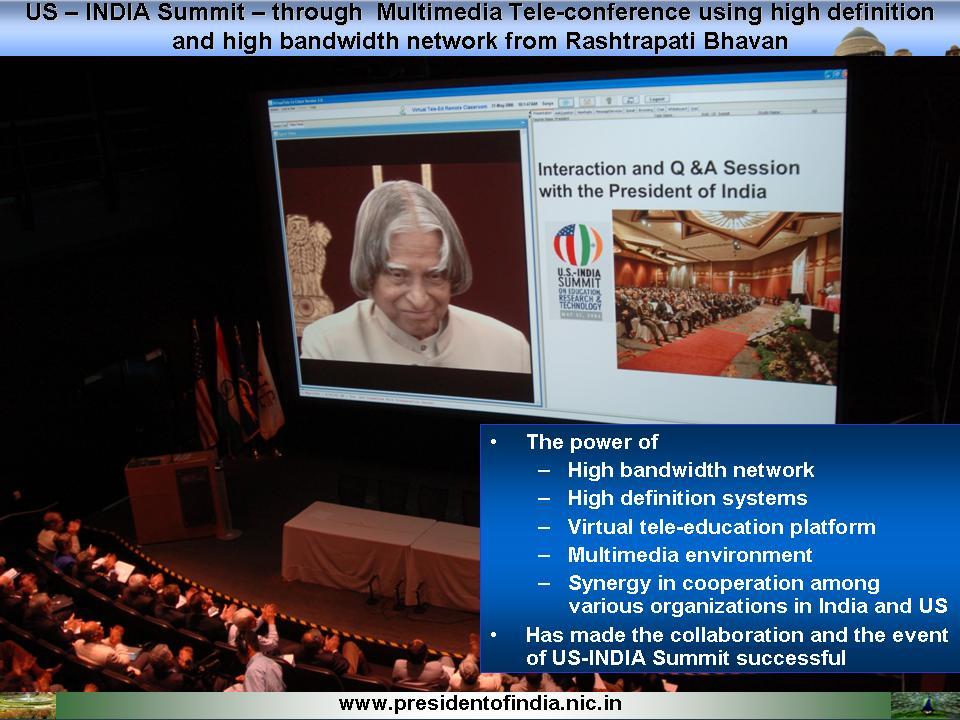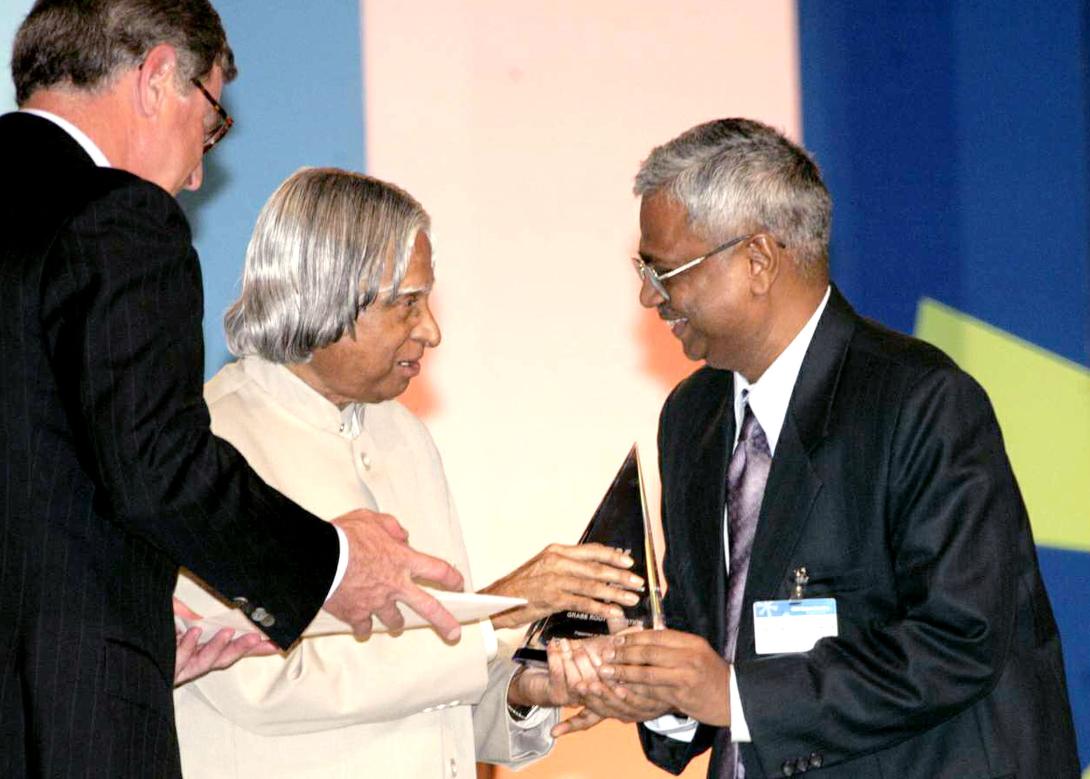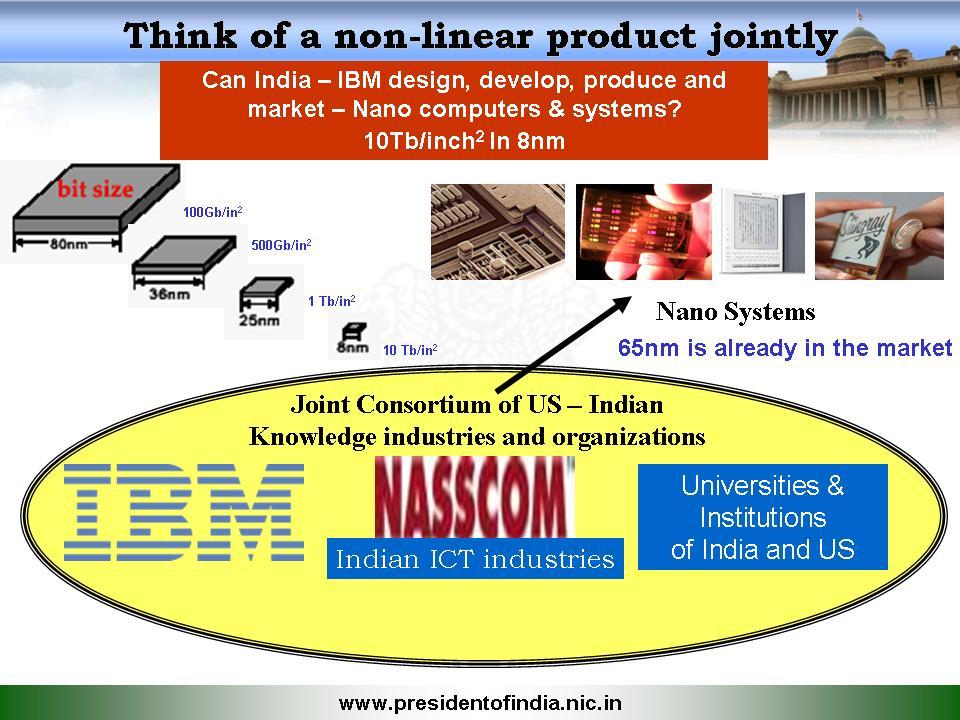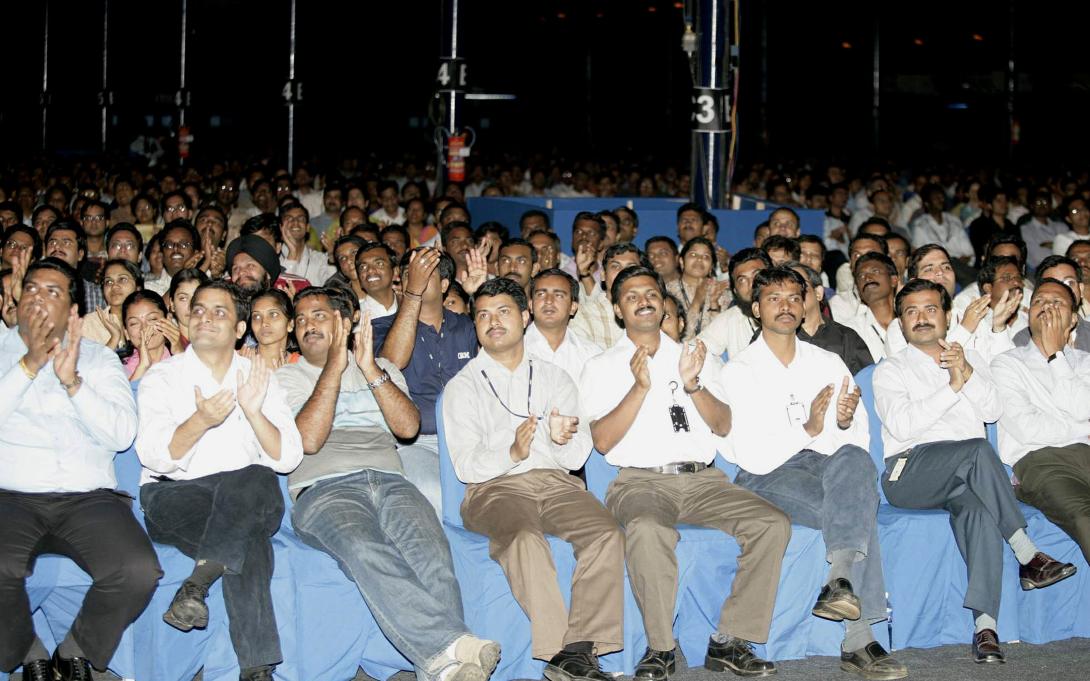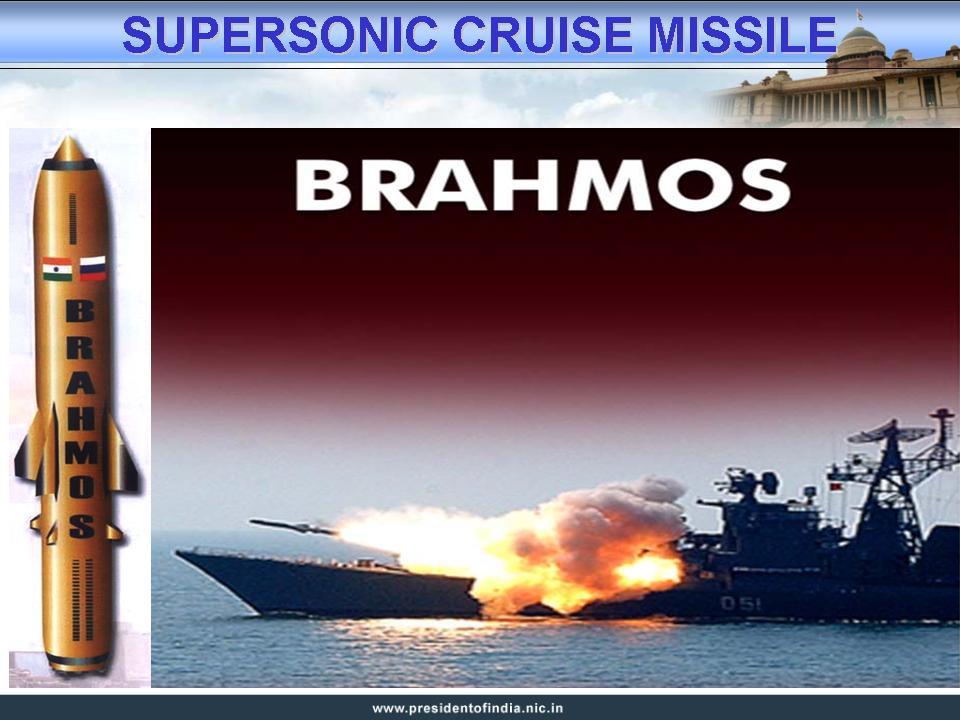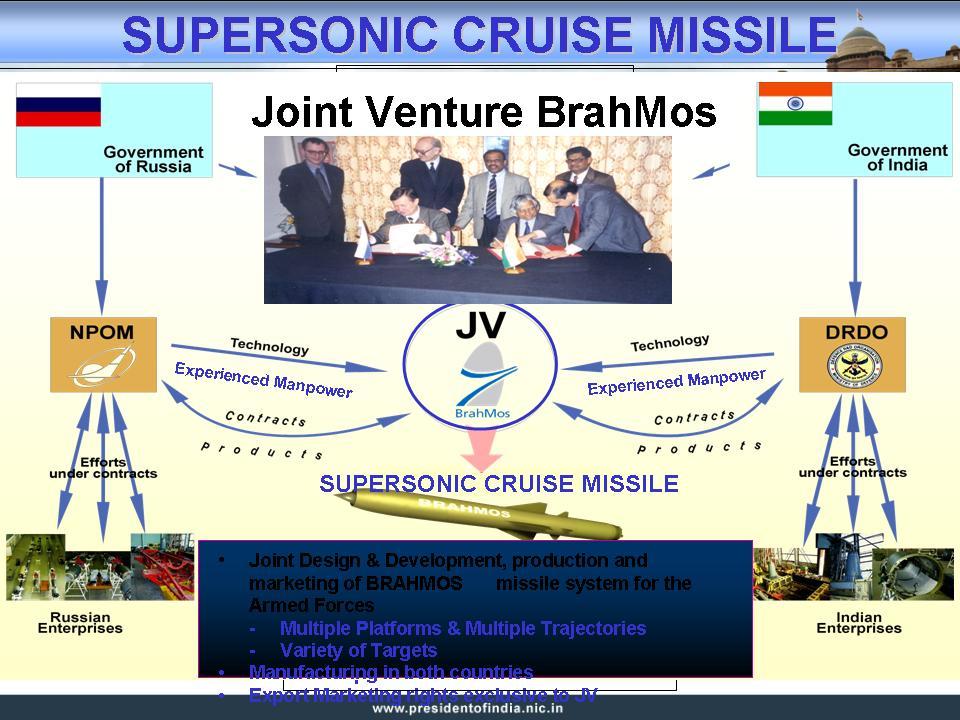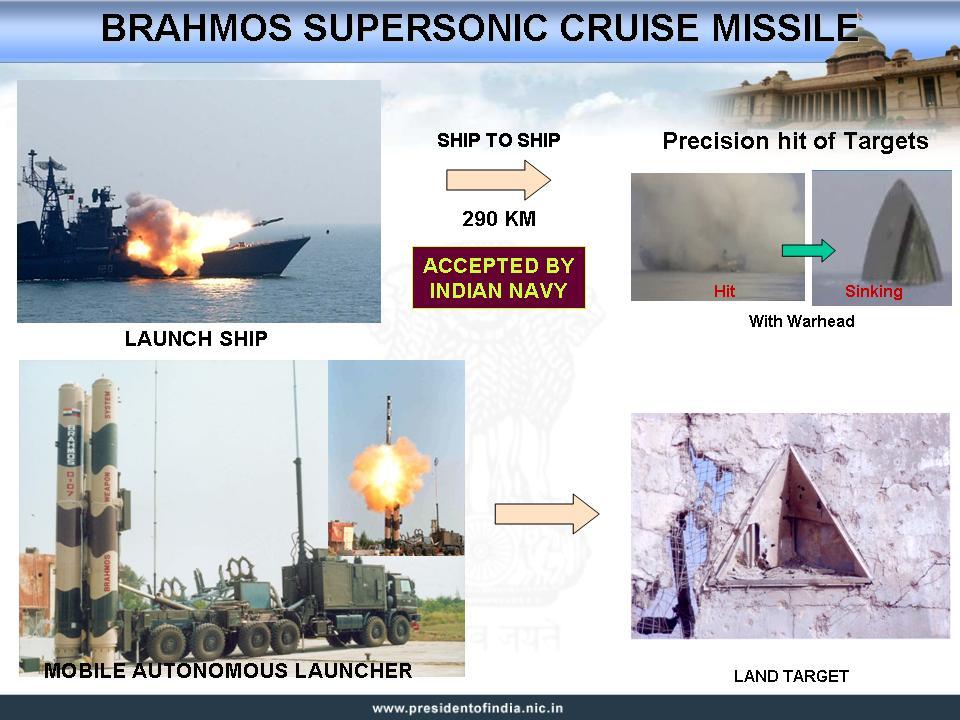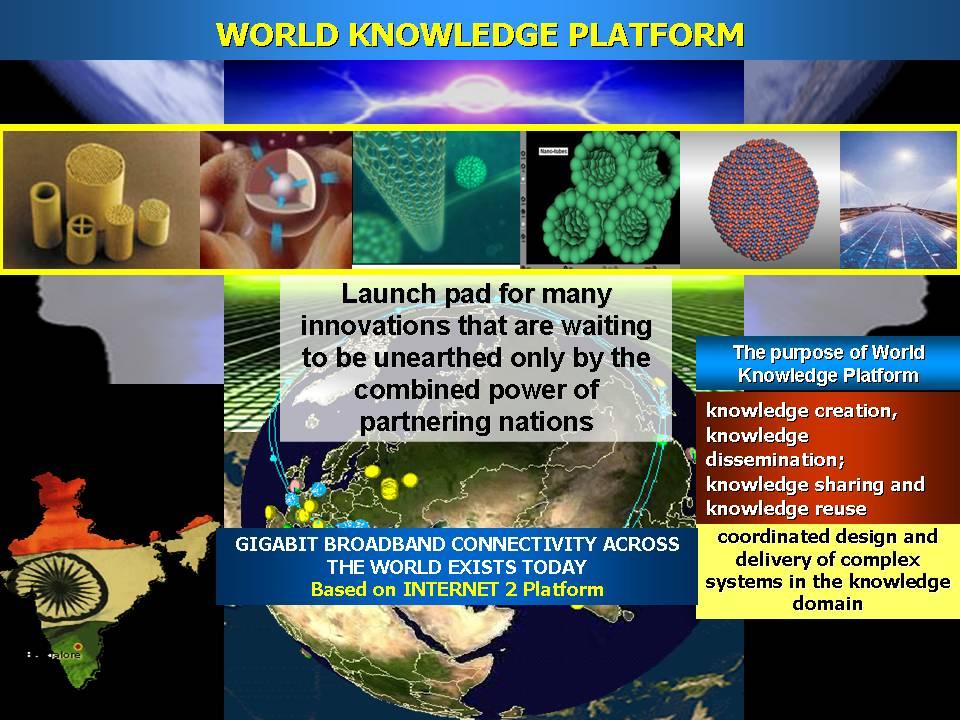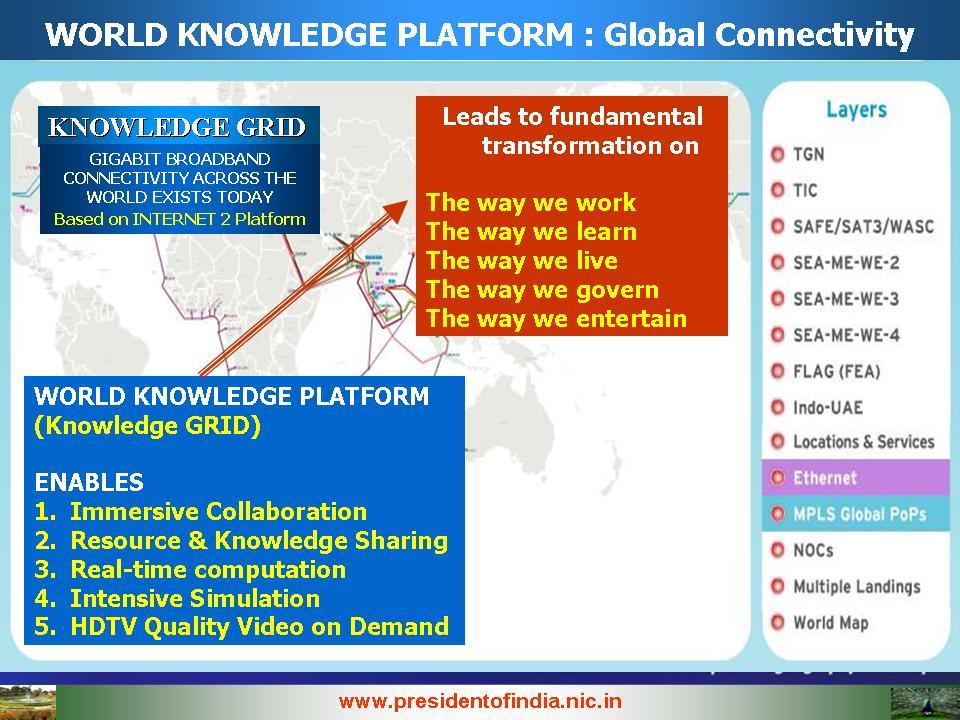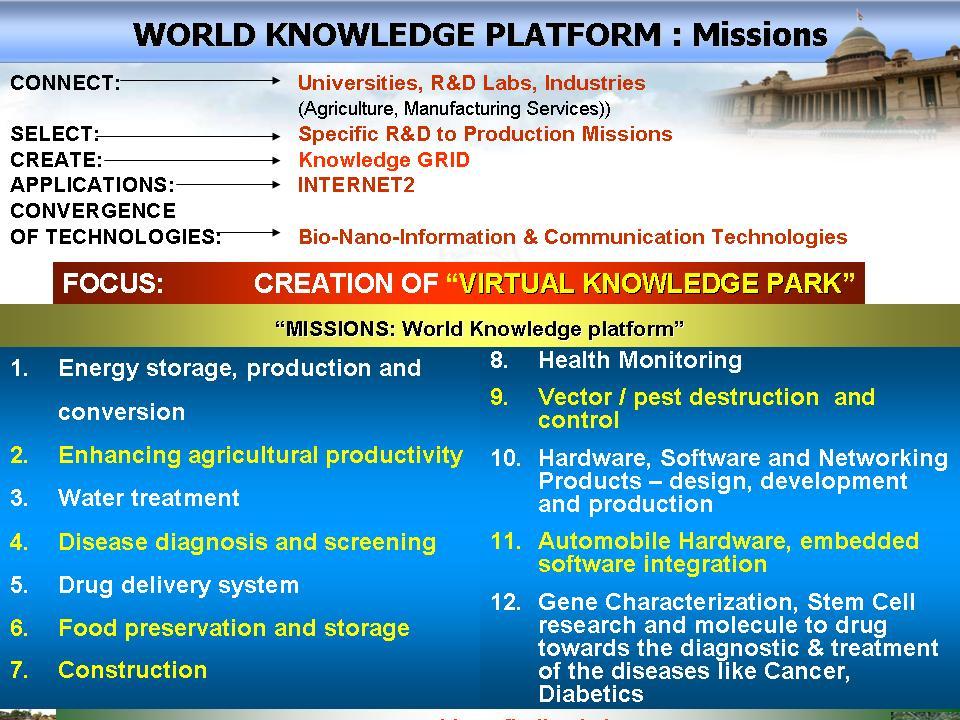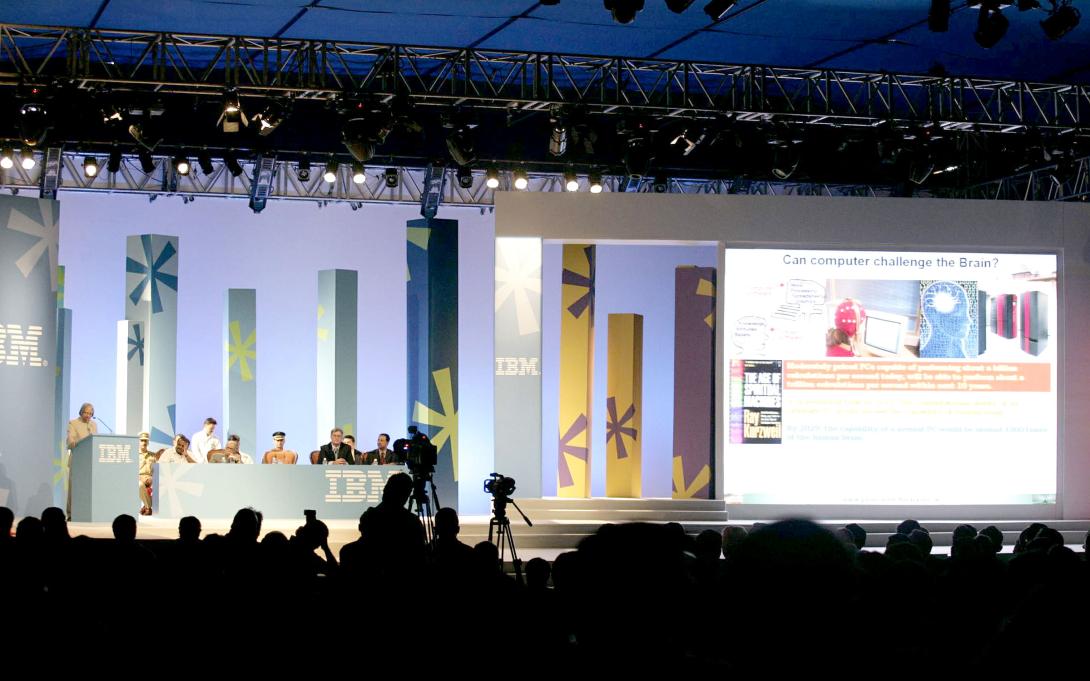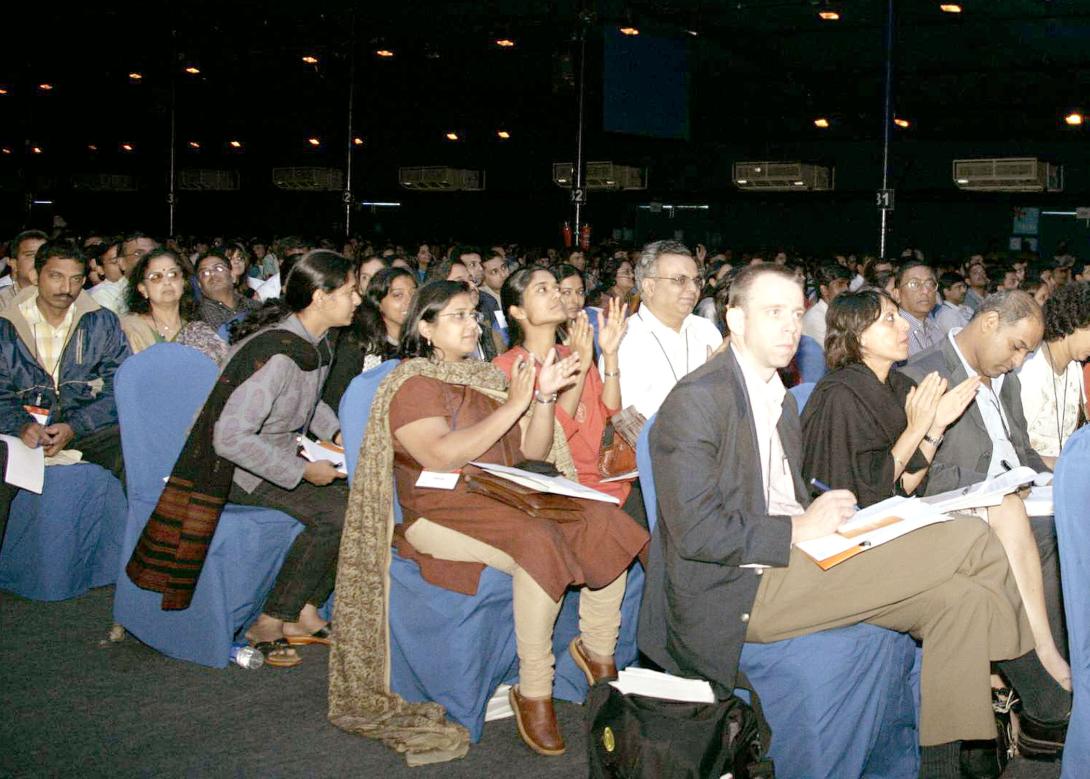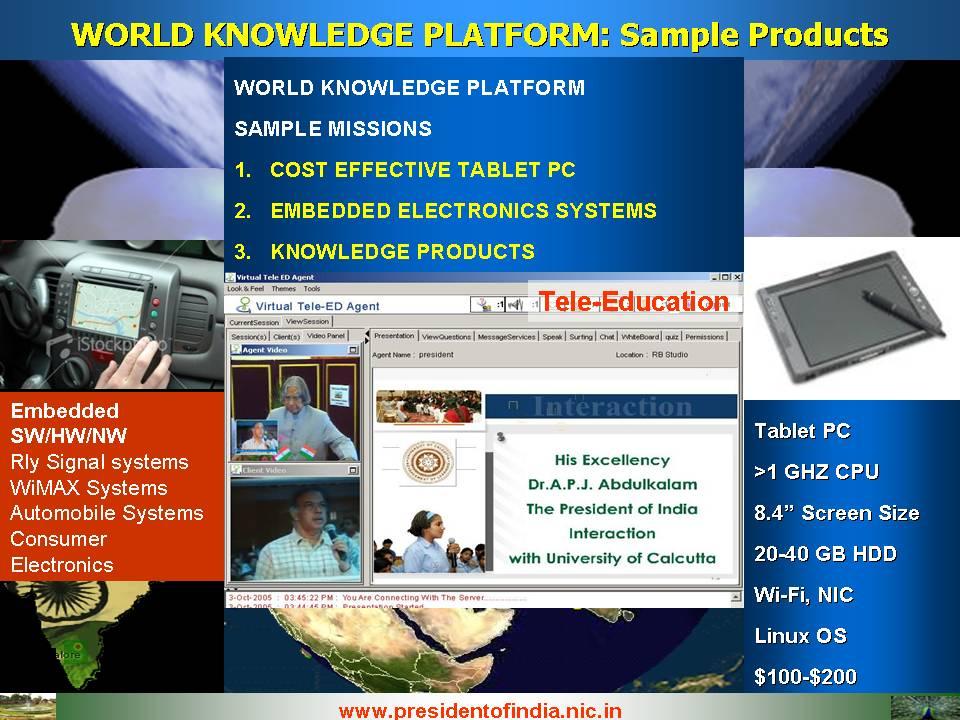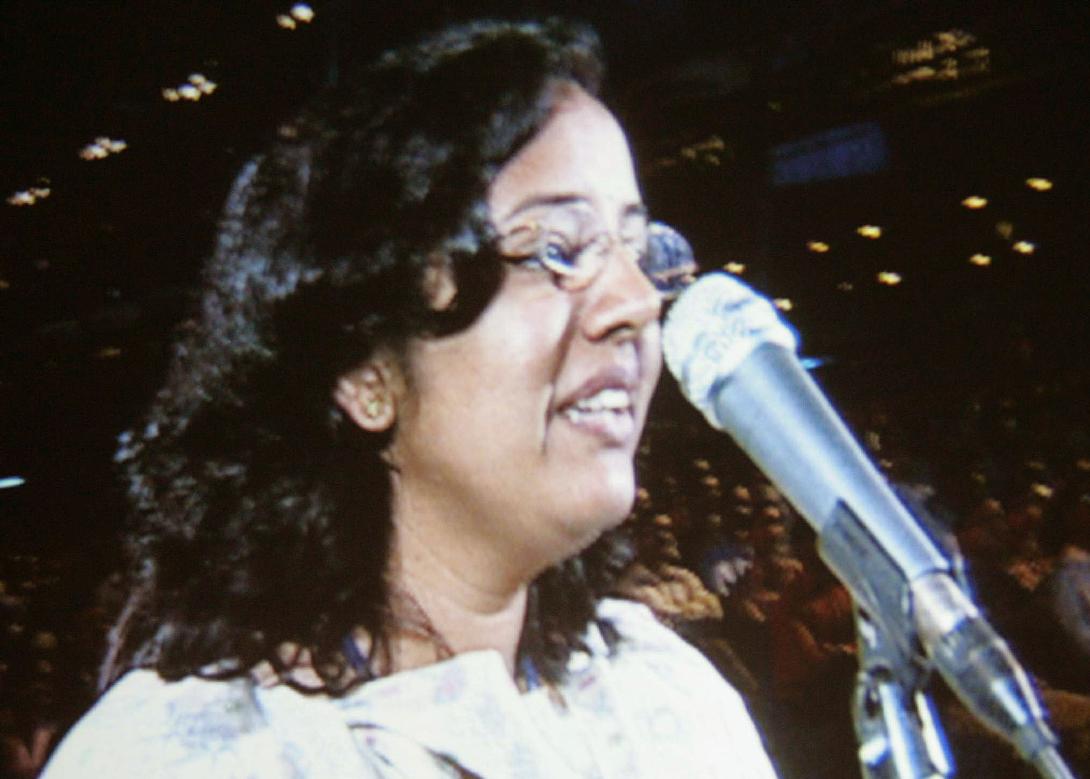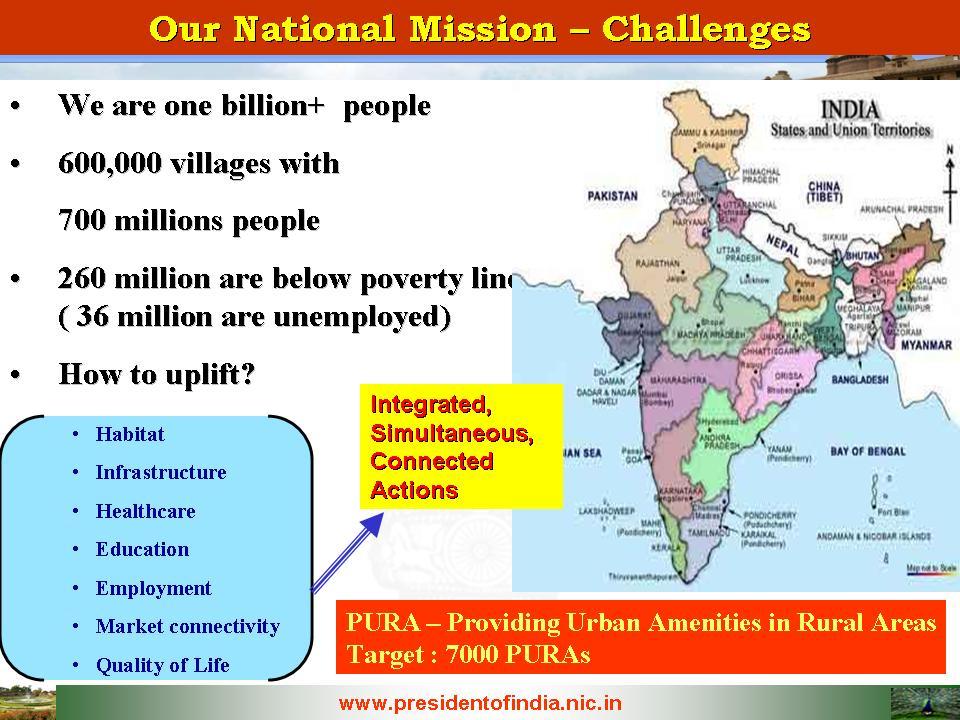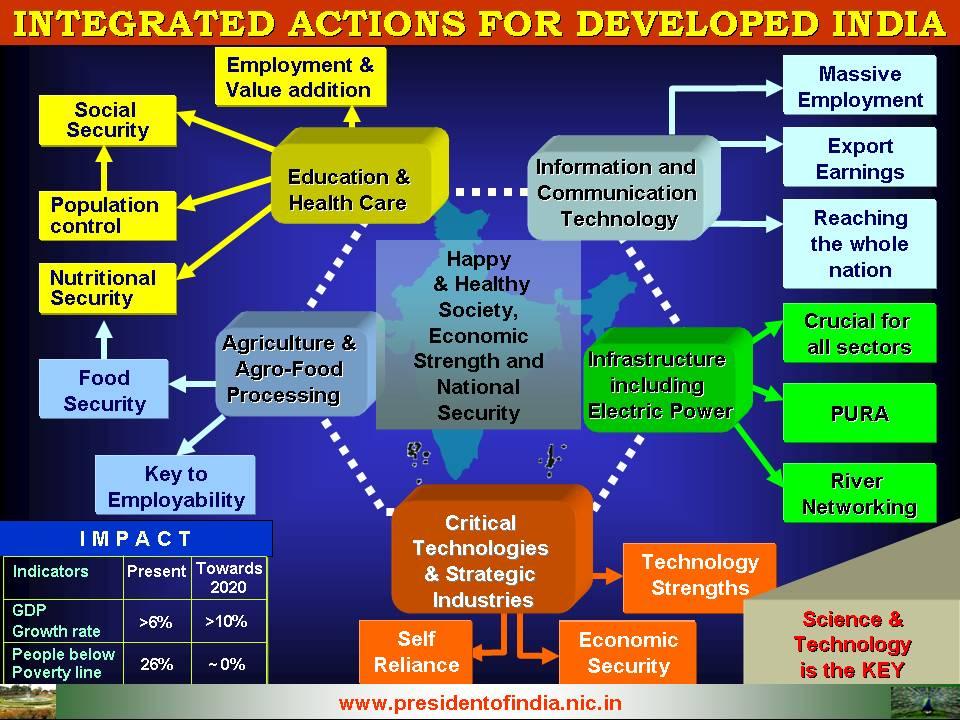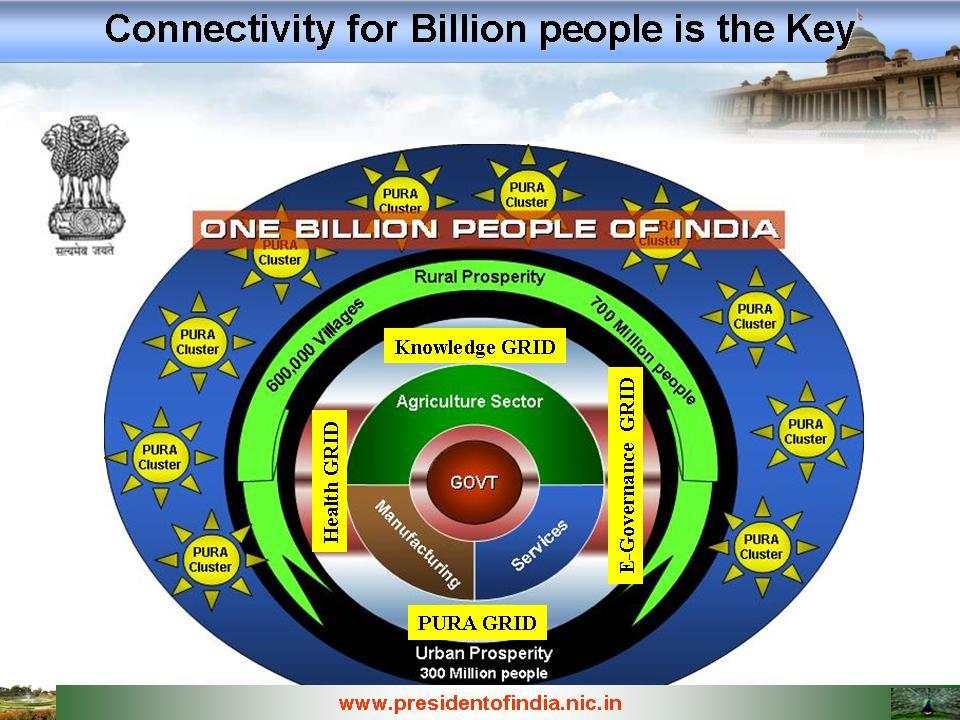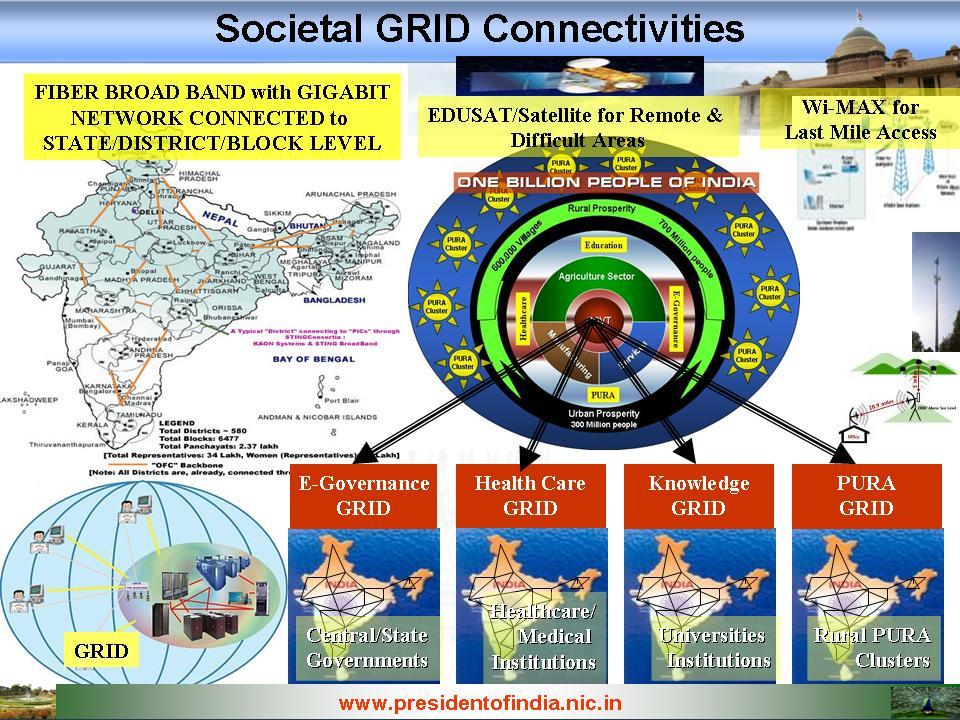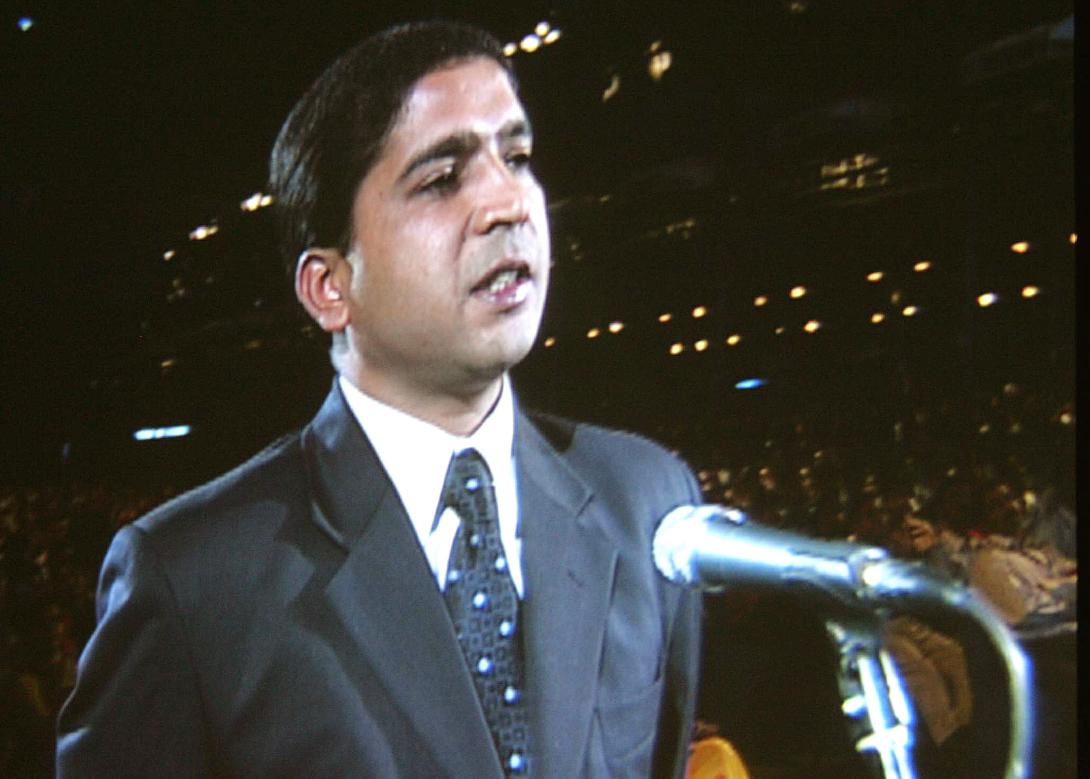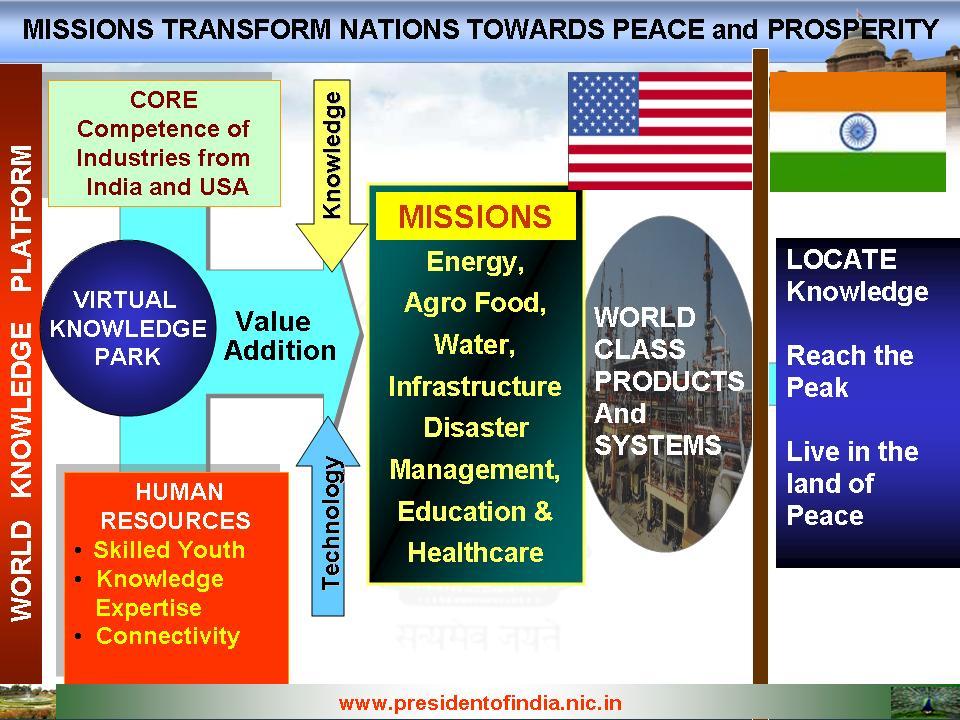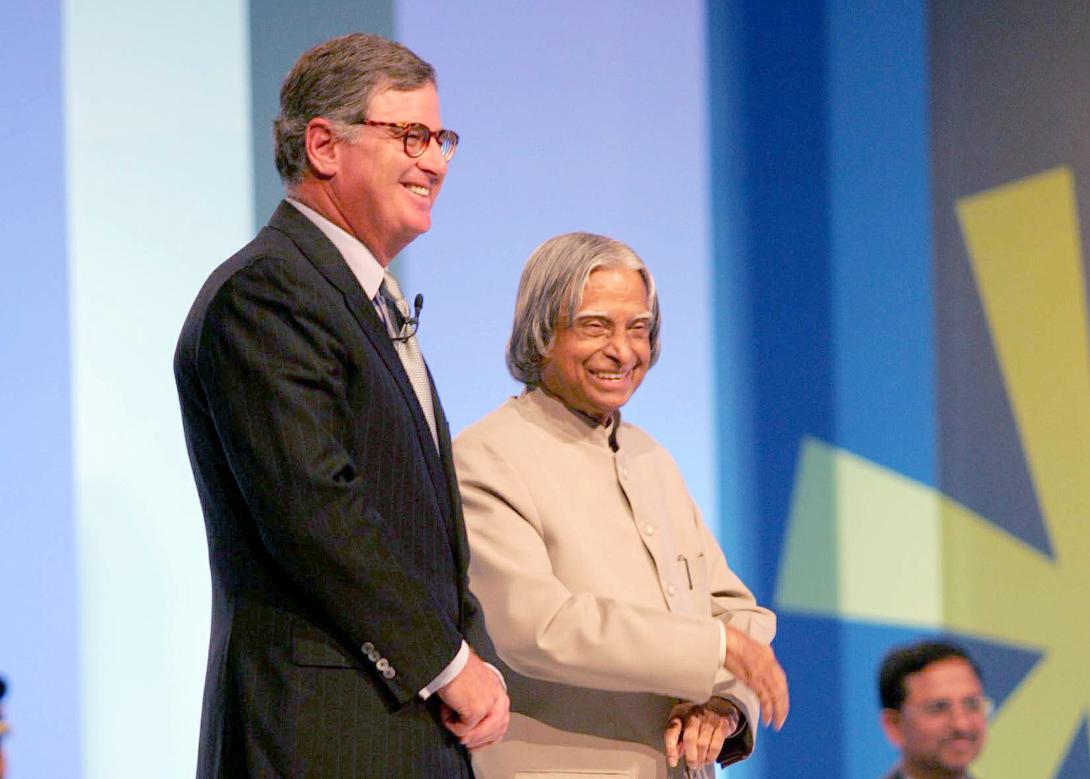Address at the Innovation and Leadership Forum, Bangalore
Bangalore : 06-06-2006
World Knowledge Platform
"Small aim is a crime"
I am indeed delighted to participate in the Innovation and Leadership Forum organized by the IBM Corporation. I greet all the business leaders, academicians, financial analysts, young scientists and engineers, investors and members of IBM community.
Visionary Leaders make the nation great
IBM Founder: The phenomenal growth of IBM has arisen due to the motivational and visionary slogan "THINK", of the founder of IBM, Thomas J Watson. This slogan reminds me of my call to the children "Thinking provides knowledge, Knowledge makes you great". During the 20th century, computer industry has undergone very rapid change and the prediction for 21st century is: the performance of the computers may challenge the human mind. When I read the book on "The Maverick and his Machine - Thomas Watson Sr. and the making of IBM", I realize how one man's vision has led the organization to became a global giant in computer science and technology. In reality, I am seeing in front of me, how the vision "THINK" of Watson has crossed the Atlantic Ocean and become global and borderless. Today I am witnessing here the impact of IBM in India and Indian youth which is a beautiful tribute to the founder of IBM. From the tabulating machine business in the early part of 20th century, IBM Corporation today has become a $91 billion information technology company with teams of about 3.5 lakh knowledge workers in 75 countries around the world, serving over 174 clients speaking more than 165 languages.
Indian Space Visionary: Now I would like to share with you, India's great visionary in space science and space technologies Prof. Vikram Sarabhai, who was my Guru. Very rarely, in the life journey, great human beings influence one's life. I was fortunate to work with Prof. Vikram Sarabhai for seven years. While working closely with him, I saw the dawn of the vision for the space programme in a one page statement. Witnessing the evolution of this one page by many years of ceaseless work by a cosmic ray physicist, a great scientific mind was really a great learning for me. Also I was thrilled to see the famous vision statement of Prof Vikram Sarabhai made in the year 1970 which states "India with her mighty scientific knowledge and power house of young, should build her own huge rocket systems (satellite launch vehicles) and also build her own communication, remote sensing and meteorological spacecraft and launch from her own soil to enrich the Indian life in satellite communication, remote sensing and meteorology." When I look at this vision statement now, I am overwhelmed to see the results of this statement. Today, India can build any type of satellite launch vehicle, any type of spacecraft and launch from Indian soil and also it has all the capability with its mighty facilities and powerful human resource. The ICT has made tremendous contribution towards the high performance onboard computers and advanced embedded software systems in the Indian launch vehicles and spacecraft programmes. Through space technology and space science, India can be a partner in the world space programme to enrich the planet earth and further exploration.
These visionary leaders have created great organizations and enriched the nations' economic prosperity. Now let me discuss what our future technological challenges are.
Can computer challenge the Brain?
Most of the computers of the future and accessories will be micro sized, wearable and will have wireless communication with each other. Moderately priced PCs capable of performing about a billion calculations per second today will be able to perform about a trillion calculations per second within next 10 years. It is predicted that by 2019, the computational ability of an ordinary PC would exceed the capability of human brain. By 2029, the capability of a normal PC would be around 1000 times that of the human brain. (Reference: The age of spiritual Machines by Ray Kurzweil)
My view is definitely the creativity of the human mind will always be superior to the most powerful computers in the horizon. Creativity has to be the business of IBM and other knowledge organizations.
By the end of this century, there would be a strong trend towards convergence of human thinking with the world of machine intelligence that the human species initially created. When there would no longer be any clear distinction between human and computers, how would the molecular biologists help us to retain the supremacy of man over machine? Computers are going to give us a challenge. It is not only for the ICT and biotechnologists; the entire scientific community would have greater responsibility of keeping the mankind above the man-made computers, human creativity being the prime mover. Corporations like IBM have to perform and grow in this dynamic and competitive environment.
Borderless world
I would like to share with you my recent experience which took place on 31 May 2006. I addressed the US-India summit on Education, Research and Technology organized by University of California, Santiago and Callit2. It is a unique Multimedia Tele-Conference between India and USA through a high bandwidth network. The High Definition systems has been used at both ends and using the Virtual tele-education platform from Rashtrapati Bhavan Multimedia Studio. An integrated action by a number of public and private organizations both from India and USA worked together to establish the hassle free high bandwidth connectivity between Rashtrapati Bhavan and UCSD. Through this high bandwidth connectivity, the US audience felt my virtual presence in their hall through a high definition projection system in big screen for the whole duration of my lecture and interactive question
answer session for around 90 minutes. I felt that the audience was really with me, even though it is virtual and 12,000 km away. During the lecture, I could refer my website, digital library, whiteboard along with my power point presentation on line through the Virtual Tele-ED platform. This experience made me realize the power of technology as an integrator of minds leading to a borderless world without geographical barriers ? a symbol of universalisation. This power of networking can definitely be used by IBM and other knowledge enterprises in India to work for a common goal which leads to economic prosperity.
Creativity
In a knowledge society, we have to make innovations continuously. Innovations come through creativity. Creativity comes from beautiful minds. It can be anywhere and any part of the world. It may start from a fisherman hamlet or a farmer's household or a dairy farm or cattle breeding center or it emanates from class rooms or labs or industries or R&D centers. Creativity has got multi dimensions like inventions, discoveries and innovations. Creative mind has the ability to imagine or invent something new by combining, changing or reapplying existing ideas. Creative person has an attitude to accept change and newness, a willingness to play with ideas and possibilities, a flexibility of outlook, the habit of enjoying the good, while looking for ways to improve it. Creativity is a process through which, we can continuously improve ideas and find unique solutions by making gradual alterations and refinements to our works. The important aspect of creativity is: seeing the same thing as everybody else, but thinking of something different.
Think of a non-linear product jointly
IBM is traditionally driven by Watson's vision of "thinking" as a launch pad. I was thinking what can be launched from IBM's launch pad, particularly from India. Can IBM and an Indian enterprises and academic institutions with their combined core competence launch a system or a product that will be new to the world as Watson's "THINK" slogan made a great change to the world of computers' Can India and IBM think together for design, develop, produce and market nano computers with 10 terabytes/inch2 in 8 nano meters size chip Is it possible? I am sure you may have many experiences. Let me share with you a unique experience of developing a complex system through a joint venture using the core competence of two nations, which may be useful for the people who are assembled here and also who are witnessing the programme in different parts of the world. The technological cooperation of the two countries, the managerial cooperation of the two nations and the investment of around two hundred million dollars by each nation has enabled the realization of Supersonic Cruise missile called BrahMos within 5 years. This is the only supersonic cruise missile in the world today. Let me discuss about the joint venture experience between India and Russia.
Supersonic Cruise Missile
One of the significant technological breakthroughs of 2005 is the design, development and productionization of Supersonic Cruise Missile-BRAHMOS by an Indo-Russian joint venture. BrahMos is the first supersonic operational cruise missile in the world which can be launched from multiple platforms such as ships, submarines, road mobile and silo, and with modifications from aircraft. This is indeed the result of technological co-operation leading to operational system. The supersonic speed is achieved by a liquid ramjet engine and the guidance is through powerful software embedded in the on-board avionics integrated with high performance sensors. The fast response Inertial guidance system with software injected sensors and agile homing head enables the missile to achieve variety of trajectories flying at speed Mach 2.8 and destroy the target with high accuracy.
The flight trajectories are simulated through a modular, digital and fully automated Fire Control System which has advanced software for way point maneuvering, with supersonic speed to provide high operational capabilities. This technological innovation is the trend setter in the cruise missile field. The robust design of the missile, elaborate ground tests and simulation has ensured 100 percent success rate in all the flight tests conducted for the Armed Forces by the joint venture company. In successful design, development, production and marketing of BRAHMOS missile, an innovative way of technology co-operation has emerged between India and other countries for multi-billion dollar business. Based on this experience, I am suggesting the creation of a World Knowledge Platform for realization of world class products for commercial applications using the core competencies of partner countries which will meet the needs of many nations. I am seeing in front of me, an IBM Indian environment, I would like to discuss with you friends, how to evolve commercially competitive, world class products or systems that can come out of certain unique core competence of IBM Corporation and Indian knowledge industries. This is indeed a great challenge, something bigger than BrahMos for commercial world. How to achieve it? I am putting forth certain thoughts.
World Knowledge Platform
During my recent visit to Singapore, Philippines and Republic of Korea, I put forward the concept of "World Knowledge Platform", which will integrate the core competencies of the partner countries to develop knowledge products. I have also proposed this concept in my address to the US-India Summit, organized by University of California, Santiago on 31 May 2006. This world knowledge platform will enable joint design, development, cost effective production and marketing of the knowledge products in various domains.
Global Knowledge Connectivity: Initially, the mission of World Knowledge Platform is to connect and network the R&D Institutions, Universities and Industries using fiber broadband from the partner nations on selected R&D missions. The underground fiber cable infrastructure already exists among many partners. This global knowledge connectivity will support multitude of seamless connections supporting both synchronous and asynchronous communication, carrying either text or audio and video in a multimedia environment. We can then use this network in the academic environments to teach courses online and share expensive equipments remotely. In the Industrial environment, it can be used to design complex systems ? even ones that are as complex as an aircraft in a collaborative way using virtual prototyping concepts in the cyber space. I realize, the impact of ICT and the power of networks in every domain of our life. For the development of any system or products the power of connectivity and collaborative effort is the key, which is the basic foundation for the World Knowledge Platform.
Missions of World Knowledge Platform: The convergence of Bio, Nano and ICT is expected to touch every area of concern to the humanity. The "World Knowledge Platform" will take up missions, in some of the areas given below, which are of utmost urgency to all of us to make our world a safe, sustainable and peaceful and prosperous place to live:
1. Energy: exploration, storage, production and conversion
2. Water: treatment and desalination
3. Healthcare: Diagnosis and drug delivery system
4. Food: preservation, storage and distribution
5. Knowledge products :Hardware, Software and Networking Products
6. Automobile: Hardware and embedded software integration
7. Gene characterization, stem cell research and molecule to drug development towards the diagnosis and treatment
8. Herbal and natural products complementary to modern medicine
9. Space based systems
In addition to the areas mentioned above, electronics, ICT and automobile sectors may also be focused especially in the areas of design, development leading to productionization for meeting the market demands of the respective countries and also for world market using the core competence of partner countries. The world knowledge platform will also evolve a virtual design center with the participation of collaborating countries.
For example, to start with the following specific missions can be undertaken by World Knowledge Platform.
(a) Tablet PC
Joint design, development and manufacture of a handheld tablet Personal Computer (PC) with multilingual capability in a cost effective manner with open source operating system and software configured for the school students and the common world citizens. The students should be able to use this as a digital book, notebook and as an e-learning device, which will reduce their carrying load and will be useful for their whole educational duration. The one time investment must make the students life easy that will give them enough time to be creative in their studies. This tablet PC will have the wireless connectivity so that it can take care of the communication needs and possibly the telephone and will have sufficient video capability to act as an entertainment platform and for tele-education and telemedicine and even a hand writing recognizer that will also permit authentication for secure e-business transactions. The challenging task will be to configure, develop and produce and market the tablet PC at a cost of $150, so that students, teachers and researchers of many nations can use it. IBM can think of possible collaborations or consortium with Indian industries for the development of integrated hardware, software integrated system that will be useful to the 300 Million Indian students alone apart from the other common users, professionals and executives of multiple countries.
(b) Embedded electronic Systems
Design and development of embedded systems integrated with hardware will have tremendous application in automobile sector, railways, consumer electronics, aerospace systems, defence systems and precision manufacturing. For example, automation of railway signaling system with wireless relays which will ensure fool-proof signaling and prevent accidents. Design and development of Wi-Max standard switches, routers and access points will have a big market for last mile connectivity in many countries at an affordable cost. The concept of ?World Knowledge Platform? can be utilized by ICT companies functioning in the Information and Communication Technology sector for collaborative research, development, production and marketing of products and systems using consortium approach.
Our National Mission - Challenges
For transforming India into a developed nation and bring prosperity to all the one billion plus people, we have identified five areas where India has core competencies for integrated action: (1) Agriculture and food processing (2) Education and Healthcare (3) Information and Communication Technology (4) Infrastructure for all parts of the country such as reliable and quality electric power and surface and air transport and (5) Self-reliance in Strategic sectors. These five areas are closely inter-related and when effectively addressed, would lead to food, economic, energy and national security and lead to sustainable prosperity.
Technology based Societal Grid
70% of the one billion population of India live in six hundred thousand villages. To provide quality life style for the people living in the villages, we have evolved a rural development concept called PURA (Providing Urban Amenities in Rural Areas). This involves development of physical
connectivity, electronic connectivity and knowledge connectivity to the rural clusters of 20 to 30 villages with a population of around 20,000 to 50,000 people leading to economic connectivity. The country will have around 7000 PURAs. Development of technologies and their convergence have significant influence on the society in terms of providing knowledge, health care, governance and economic development established through connectivities among them. These connectivities will certainly bring seamless access and information flow among the various domains leading to maximization of GDP and productivity; hence, there is a need for establishing the GRIDs namely Knowledge grid, healthcare grid, e-governance grid and the PURA (Providing Urban Amenities in Rural Areas) grid. This interconnecting grid will be known as societal grid. Knowledge sharing, knowledge utilization and knowledge re-use are very vital by all constituents of the society for promoting non-linear growth. Details of Societal Grid are:
1. Knowledge GRID - Inter connecting universities with socio-economic institutions, industries and R&D organizations.
2. Health Care GRID - Inter-connecting the Health Care institutions of Government, Corporate and Super specialty hospitals, research institutions, educational institutions and ultimately, Pharma R & D institutions.
3. e-Governance GRID - Inter-connecting the Central Government and State Governments and District and Block level offices for G2G (Government to Government) and G2C (Government to Citizen) connectivity.
4. PURA GRID - Connecting the PURA Nodal centers with the village knowledge centers and domain service providers.
We have, so far discussed all the four connectivities required for the societal transformation of the nation. These GRIDS will help the World Knowledge Platform to enable reaching the resultant knowledge to the people directly.
Conclusion
Let us think together, what are the types of enriched partnerships possible between IBM Corporation and Indian knowledge product industry. Three distinct areas can be identified. They are, (i) Transforming India into knowledge society with innovation as the thrust area influencing the information society, industrial society and agricultural society. (ii) As you are aware India has 540 million youth below 25 years which is an important asset for the planet Earth. This dynamic resource will have two components. One, at the secondary education level supplemented with high quality vocational skills and the other at the university level. Knowledge workers will come out of this Global Human Resource Cadre. Definitely, IBM Corporation can participate in the evolution of trained human cadre. (iii) Participation in the "World Knowledge Platform" will empower the IBM Corporation (India) and the partner institutions with the collective core competence as a base.
For success in all these missions, which we have discussed so far, we need creative leaders. Creative leadership means "exercising the vision to change the traditional role from the commander to the coach, manager to mentor, from director to delegator and from one who demands respect to one who facilitates self-respect". I am sure creative leadership will spearhead all the institutions and the future aspiring institutions. For promoting growth of organization, the important thrust will be on the growth in the number of creative leaders and innovative personnel who can create wealth through dedicated management system.
Such leaders in organizations will facilitate global competitiveness and help in creation of knowledge societies in the Planet. Particularly the mission of creative leaders will be the evolution of enlightened societies through the "World Knowledge Platform".
Wish you all the best. May God Bless you.
Question and Answer Session
1. Mr. President, leadership is an important enabler for growth. What would be the key leadership qualities for future leaders in an emerging economy like India?
- Krishnamurthy Deepa N, Global Business Services
Ans: Vision, balanced view, "we can do it" spirit and indomitable spirit are the key leadership qualities for our future leaders in the emerging economy
2. Mr. President, what is the most memorable event in your life?
- Ms. Suchitra Srinath, IBM Sales and Distribution
Ans: Removal of pain of a young girl affected by the polio and her ability to ride a bicycle after using the light weight Floor Reaction Orthosis made by using carbon-carbon material was the most memorable event in my life.
3. Sir, I would like to have your personal view - what do you think makes India special?
- Ms. Shoba Krishnan, Manager HR Strategy, IBM India Ltd.
Ans:India, as the largest democracy in the world has a reputation for its democracy and for providing leadership for the one billion people with multi-cultural, multi-language and multi-religious backgrounds. This makes India special.
4. Sir, it is reported by many commentators that India needs to improve its basic infrastructure to ensure its continuing high growth. What role do you see for technology in improving the infrastructure across India?
- Ms. Padma Dhayanand, IBM Sales and Distribution
Ans: Technology has a great role to play in fast improving of infrastructure. Pre-fabricated construction of fly-overs for fast erection, commissioning of metro systems, use of green building material, providing quality power through renewable energy sources, pollution free transportation system are all technology dependent infrastructure missions.
5. Mr. President, thank you for gracing us with your presence today. What is the role of technology in rural transformation?
- Shri Praveen Cherian, Country Manager, Global Technology Services
Ans: Technology has to play a great role in improving the quality of the life of rural people. Technology can enable quality education and health care to reach them. Technology can also provide value addition to their products and enable them to realize remunerative prices for their produce. Technology can enhance the employment opportunities in the rural sector.
6. Mr. President, there is an important role that companies like IBM can play at the intersection of business, technology and society. What would be the key areas of focus?
- Shri Vivek S Rawat, Software Sales Manager
Ans: Technology enhances the ability to face competition in business. Success in business promotes prosperity of the enterprise. Societal missions enable the business to share their prosperity with the society. Here again technology assists in execution of societal missions.
7. Sir, As you have always articulated great vision for India, what would be the top three focus areas in next 10 years for India?
- Shri Joe Joseph, Territory Services Leader
Ans: Development of human capital, energy independence and implementation of 7000 PURAs are the top three focus areas for the country.

